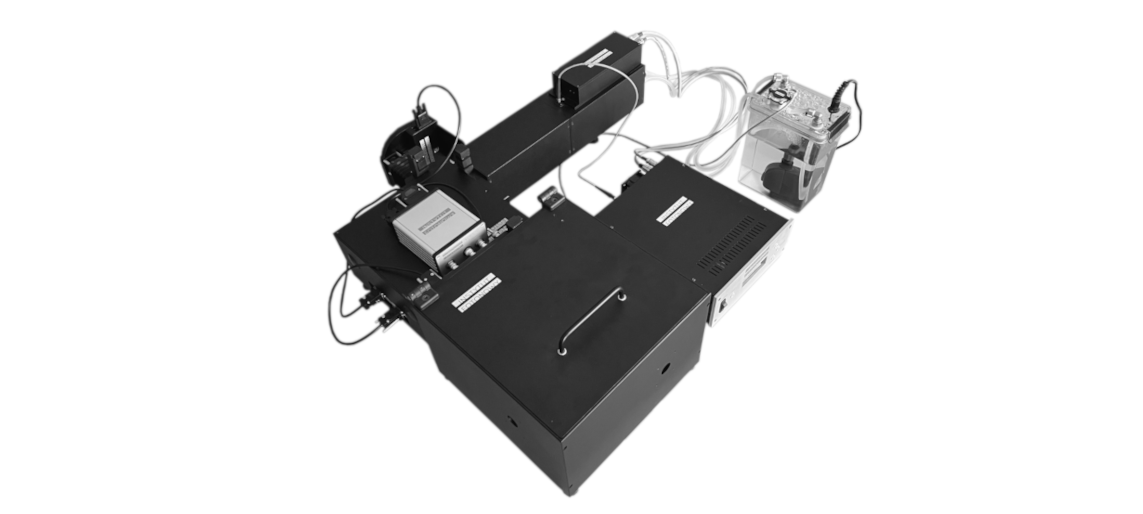Large Photoelectric Spectrometer for static and kinetic quantities exploration
Couldn't load pickup availability
Delivery and Shipping to EU
Delivery and Shipping to EU
We will add in the quotation, the shipping, insurance, customs clearance costs.
Large Photoelectric Spectrometer for static and kinetic quantities exploration
Instytut Fotonowy
Large Photoelectric Spectrometer is an instrument that combines the Photoelectric Spectrometer functionality with the Intensity Modulated Photocurrent/Photovoltage Spectroscopy (IMPS/IMVS), Solar Simulator and Impedance Camera. It is completed with the Light Calibrator accessory that enables light transmission measurements and the on-demand system recalibrations.
With this instrument you can apply various measurement techniques to a sample without moving it between different measuring setups. The central part of the system is a Monochromator with two input slits and an additional mirror on the turret. At the first Monochromator entrance, the Xenon Lamp is attached. It provides continuous supply of wavelengths and is a base for a Solar Simulator. The second Monochromator input is occupied with a LED Revolver with 10 LED sources. The LED Revolver provides the light intensity modulation for time scales investigations. The light from the LED Revolver may be directed to the Sample Chamber via the mirror or the grating. Combining the LED Revolver with the grating provides better spectral resolution and wide light intensity modulation range.
The light source selection and its operation is controlled via software.
Quantities measured by the instrument:
Electric current through the sample at a given bias potential (chronoamperometry, CA),
Open Circuit Potential (OCP) as a function of light wavelength or in dark,
Photocurrent of the sample illuminated with solar (AM 1.5G) or monochromatic light,
I-V characteristics,
Light transmittance of the sample,
Incident light intensity reaching the sample,
Action maps (photocurrent as a function of potential and wavelength),
IPCE maps as a function of potential and wavelength,
APCE maps as a function of potential and wavelength (with the Integrating Sphere),
Sample reflectance (with the Integrating Sphere),
Minority carriers lifetime (recombination time),
Carrier transport time through the sample,
Rate of the charge transfer through the interfaces,
Diffusion constant,
Diffusion length for a given sample thickness,
Sample thickness for a given diffusion length,
Selfconsistent Electrochemical Impedance Spectroscopy (EIS) spectra,
Non-linear effects: higher harmonics generation, intermodulation (two frequencies in the input result in a third frequency in the output), current rectification (resistance of a sample depends on the current direction ),
Other kinetic quantities.
Spectrometer module system
Sample Chamber,
Monochromator for UV, VIS and IR light,
Potentiostat for full characterization of electric properties,
Xenon Lamp with the controller and water cooling system,
Electrochemical Cuvette with Pt Counter Electrode (CE) and Ag/AgCl Reference Electrode (RE),
LED Revolver,
Impedance Camera,
FotoGUI software.

Specifications
Instrument performance may be tailored to custom requirements.
Xenon Lamp
150 W xenon burner,
Water cooling system,
Low EM emission igniter,
Stabilization modes:
– electric current stabilization (distortions < 1%),
– electric power stabilization,
– light intensity stabilization (unique solution to provide constant sample illumination during the experiment),
Maximum radiation intensity on the sample: 35 mW/cm2
Filter Wheel
Up to six filters on the carousel,
Two edge (long pass) filters provided by default: 400 nm and 510 nm,
Air Mass 1.5G filter,
Potentiostat
Bias potential range: -5 V ÷ 5 V,
Current ranges: 10 nA, 100 nA, 1 µA, 10 µA, 100 µA, 1 mA, 10 mA,
Current resolution: from 1 pA to 100 nA (range dependent),
Controller
Maximum sampling rate: 1 kSample/s,
Connection with PC: via USB 2.0,
Two photodiode inputs that may be simultaneously handled,
RS485 socket to control devices,
Monochromator
Two input slits for two separated light sources,
Automated light source selection,
Up to three gratings on the turret,
A mirror and two gratings installed by default: optimized for 300 nm and 500 nm, both with 1200 grooves/mm,
Spectral range: 200 ÷ 1200 nm (gratings dependent),
Automated switching of the turret position, operated via software,
Motorized slits, controlled via software,
Entrance and output slit opening range: 0 ÷ 5 mm,
Motorized internal shutter that provides full cut off of the light beam, controlled via software,
Maximum spectral resolution: 0.1 nm (depends on the input and output slits width),
LED Revolver
10 LED slots,
Default LED set: 365 nm, 385 nm, 405 nm, 450 nm, 520 nm, 590 nm, 630 nm, 740 nm, 840 nm, white (3000 K),
Custom LED selection available,
Typical electric power of LEDs: 3W,
Light intensity modulation: square, sinusoidal, triangle, sawtooth waveforms with adjustable amplitude and bias light intensity,
Light modulation frequency range: 1 µHz ÷ 10 kHz.
Impedance Camera
Frequency range: 1 mHz ÷ 1 MHz,
Sampling rates: 1.22 kHz ÷ 10 MHz,
Current ranges: 1 mA, 100 μA, 10 μA, 1 μA, 100 nA, 10 nA,
Current resolution: < 1 pA,
Voltage range: -1 V ÷ 1 V,
Voltage resolution: < 100 μV,
Typical light intensity output of the Large Photoelectric Spectrometer
The light intensity produced on the sample depends on the wavelength and width of the input and output slits. In the picture, a typical light intensity from the Xenon Lamp and two 1200 gr/mm gratings: optimized for 300 nm and for 500 nm installed in the Monochromator.




